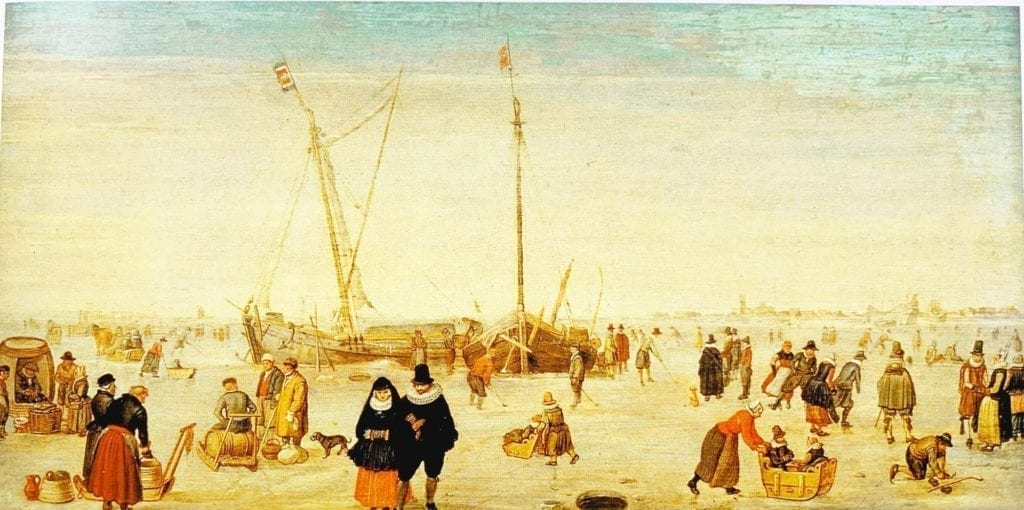Mute painter Hendrick Avercamp sings an icy opera with Frozen River. His expressions range from delight to death in this painting. Without a word spoken, Avercamp tells us a complex emotional story. It’s a dramedy. People frolic to the tune of 1620. That means long, poofy frocks and stovepipe hats at a hockey game. They’re having a blast. It’s bitter cold with an icicle-white sky. But there’s a warmth to these people.
Click below for the podcast version of this post.
Jovial groups bustle across the ice. Avercamp creates charming movement with their activities. Punches of red draw the eye from men at work to ice skaters dancing. Mothers push toddlers in wooden crates past a card game. This icy scene presents a microcosm of the town set off on the horizon. We don’t really see the town. But we know what it’s like there thanks to Avercamp’s mini winter world.
Frozen River reigns supreme among Avercamp’s many chilly landscapes. Icy bodies of water were his specialty. Many compared Hendrick with Pieter Bruegel, his Flemish predecessor of about 100 years. Both painted cold Nordic landscapes. Their favs were the same – detailed portraits of everyday people on a frigid body of water.
Hendrick Avercamp also explored similar themes to Bruegel. For instance, mortality. This theme dominated art more in those days. That’s because the average life-span was only about 67 years old. Death hijacked human golden years. At first Frozen River grabs us with animated teams on the ice. It’s a vital scene – packed with action. But doom awaits in the middle of this painting too.
Death on Ice
Commotion abounds in Frozen River. But there’s a standstill at its center. Ship masts pierce an icy sky like raised batons right before a song. These stuck schooners stand tall but a bit askew – ignored by townsfolk all around them. Of course, these people must see these ghost ships. They’re forced to scoot and skate around them, after all. But nobody looks at the schooners even though they command the scene. Hockey games kick off only feet away – oblivious to the towering ships. This is how humans often treat death as well.
Our mortality pokes into the hockey game of life – an inevitable ghost ship barrier. We continue to play as if it’s not there. Still, nobody gets around it. The hockey puck’s going to hit starboard at some point. These stagnant ships are not Avercamp’s only death symbol in Frozen River, though.
Another death, lies front and center at the painting’s bottom.
A black hole, cut for ice fishing foretells danger. Mystery lies in its darkness next to the clean bright clarity of ice. This represents the murky depths of the unknown. Tiny compared to the vast glaze of Frozen River, the hole’s also entry to life’s finale. To fall in would mean meeting one’s certain end. The hole contrasts our ghost schooners. Townsfolk can ignore these ships with ease. They represent no threat. While the hole belies imminent peril.
Hendrick Avercamp painted this harbinger where it can’t be missed. Center stage like a spotlight – the hole’s there for a reason. Much like the ships, this fishing hole provides contrast. Without it, Frozen River frolics with everyday jobs and joys. But this gives it weight. The hole serves as reminder that these are life’s most memorable moments. Treasure this, the hole seems to say. Remember this. You’re only a few feet away from the dark abyss.
Frozen River – FAQs
Did Hendrick Avercamp only paint Frozen Rivers?
A Hendrick Avercamp Google search will seem to say YES. But, this was a late life obsession for Avercamp. In 1613 he moved from Amsterdam back to his childhood town of Kampen, Overijssel. There he painted many Frozen Rivers until his death in 1634.
Was Hendrick Avercamp also deaf or only mute?
This is an existential and excellent question. Avercamp was known as “de Stomme van Kampen” (the mute of Kampen). Historians presume that he was also deaf. But how can we truly know? It is safe to say he was “presumed deaf”.
Why, like Frozen River, were most Avercamp paintings winter scenes?
It’s not by chance. Many artists paint from experience. Avercamp was born in a Nordic country during the last quarter of the 1500s. Turns out this was one of the chilliest periods in history. In fact, it was the coldest portion of the Little Ice Age.
Where can I see Frozen River in person?
Many of Avercamp’s 100-or-so paintings are on exhibit at Rijksmuseum in Amsterdam and in The Hague. But the exquisite and crisp masterpiece Frozen River hangs in Boymans-van Beuningen Museum in Rotterdam.
